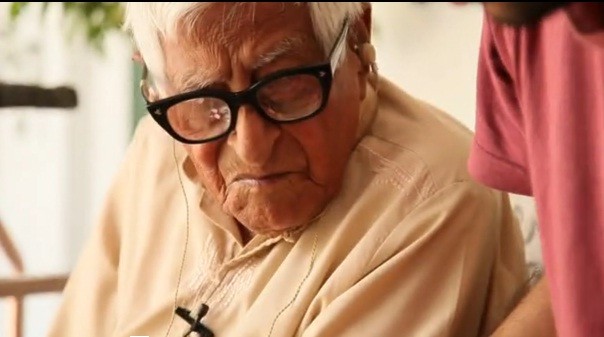
F.E. Chaudhry ‘a pictorial historian’ par excellence

Among the few people who instill in us the pride to be a Pakistani, F.E. Chaudhry certainly ranks very high in that list. More so, being a Christian (Catholic) in an ideologically orientated polity like Pakistan, Faustin Elmer Chaudhry eliciting so much love and deference is quite a feat. He was indeed a darling among the journalist fraternity. He was affectionately known and still remembered as Chacha by all and sundry.
Majid Sheikh reveals to us that his father Abdul Hamid Sheikh, a known journalist of the Pakistan Times gave Faustin the honorific of Chacha which stuck with him even after his demise on March 15, 2013.
I am personally witness to the deference and esteem that he was held in by his colleagues when a multitude of them congregated to celebrate his 99th birthday at Alhamra Arts Council. He was revered like a legend which of course he was. Being Pakistan’s first serious, full-time press photographer, F.E. Chaudhry was credited to have brought about innovative techniques and methods in photojournalism. He was a pioneer in such realms as cricket action photography, pictorial and artistic studies of birds and animals, photographs of natural and cultural scenes, which subsequently became standard items of the contemporary photojournalism.
Chaudhry lived for exactly 104 years, a long life punctuated with a sustained passion for photography, which he adroitly deployed with a sense of history. Thus he was ‘a pictorial historian’ par excellence. He captured some of the most valued historical moments of the Pakistan Movement with his camera. When Quaid-e-Azam came to Lahore in February, 1936 in a bid to resolve Masjid Shaheed Ganj issue, which had driven a divisive wedge among the Muslims, on that occasion he made a speech. Chaudhry took his picture which he considered the biggest honour for him.
Before going any further with his professional life, it will be worthwhile to shed light on Chaudhry’s family history and his own early life.
Faustin Elmer Chaudhry was born to a Christian (Naru) Rajput Family of landowners, settled in Saleempur village in Hoshiarpur District. His grandfather Ghulam Ghaus Khan was the numberdar of the village as well as the sufaidposh of the area. From his detailed interview conducted by a journalist, Munir Ahmad Munir, later on compiled in a book form titled Ab Woh Lahore Kahan, one can infer that his grandfather converted to Christianity. Thus his father Yuhanah Khan was Christian by birth. He was the eldest of his five siblings who rose to the position of a Professor of Theological seminary in Saharanpur (in U.P.).
Saharanpur was where F.E. Chaudhry was born on March 15, 1909. He was still a toddler when his father came over to Lahore as padre in Naulakha Church of Lahore. The family had its house at Mission Road. Young Faustin was sent to Municipal School Shah Alami. He was still at junior school when his parents passed away. His uncle took over the charge of Faustin’s education and overall brought up.
In the changed circumstances, he was admitted to Sir Francis School where he lived in a hostel. Mission High School Dalwal, Jhelum was the next destination for young Faustin where he completed his schooling. It was at Dalwal that he picked up photography as a hobby. But the hobby which, in due course of time, became his lifelong passion could not deter him from getting further education. For that purpose he got enrolled in FC College, Lahore and completed his bachelor’s degree.
Subsequently, he taught Science and Urdu in Saint Anthony College for 15 years (from 1934-1949). Simultaneously, he started working as a freelance for The Civil & Military Gazette, The Illustrated Weekly of India, The Statesman Delhi and The Hindu Madras. The Civil and Military Gazette published his first news photographs in 1935. In 1949, Mian Iftikharuddin extended an offer to work for the Pakistan Times as staff photographer. Although he retired from the Pakistan Times in 1973, his association with that paper lasted until 1978.
Sunny Gill is spot on in his analysis of F.E. Chaudhry photographic skill when he says, "Chaudhry’s photographs mapped the journey and growth of a nation through its highest and lowest points -- the times of Jinnah, the political uprisings during Ayub’s military takeover, Bhutto before his execution and others". He in fact created history through his camera by conserving important events.
For all the commendable work that F.E. Chaudhry performed, 27 awards, including the President’s Pride of Performance, Sitara-i-Imtiaz and the Tehreek-i-Pakistan Gold medal were bestowed on him from time. He was personable and had tenacity of purpose. His love for the country was deep and unswerving which he bequeathed to his offspring. He had three sons and two daughters. One of his sons, Cecil Chaurdhry was the hero of 1965 and 1971 wars and was decorated with Sitara-i-Jurrat and Sitara-i-Basalat. Cecil was a legendary figure in his own right who died rather pre-maturely on April 13, 2012 of lung cancer. His other son Anthony Chaudhry also joined Pakistan Airforce and rose to the rank of Wing Commander. Then he started a career as a Chief Flying instructor at Lahore Flying Club. Cyril Chaudhry, his third son works for Bata Shoe Company.His daughters are Dr. Stella Khan and Ms Sheila Rais.
As a devout Catholic, F.E. Chaudhry upheld the much cherished principles of his faith -- forbearance, a high regard for his community and most of all the capacity to bear suffering. Watching Pakistan descending into the quagmire of rising violence, discrimination against minorities and deteriorating situation of law and order dismayed him greatly. On March 15, five years have gone by since he proceeded to his heavenly abode but he is still with us as an emblem of hope and optimism. He indeed was the most prominent signification of plural values that many of us cherish and long for. He will be remembered for many years to come.